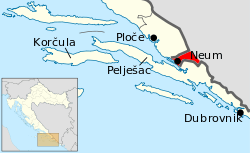Neum Agreement
The Neum Agreement is an unimplemented treaty between Croatia and Bosnia and Herzegovina granting free passage of Croatian transit traffic between the territory of Dubrovnik-Neretva County around the city of Dubrovnik and forming a pene-exclave of Croatia and the remaining Croatian territory through the municipality of Neum.
The agreement was signed in Zagreb, Croatia on 22 November 1998 and followed by a protocol of 11 December 2001 further regulating the issue. The agreement provides for unobstructed transit of vehicles with Croatian license plates and documents traveling from and to Croatian territory, prohibits loading or unloading of goods or passengers and changes of mode of transportation except in cases of traffic accidents or vehicle breakdowns, but it does allow officials of the Bosnia and Herzegovina to prohibit transit of goods whose import is not permitted due to health concerns. The agreement finally provides that it shall be in force as long as Ploče Agreement, regulating use of the Port of Ploče by Bosnia and Herzegovina, is implemented.[1][2]
As of 2012, the treaty is still not ratified (it was not published in Narodne novine)[2] and there is no actual route permitting the type of transit provided for by the agreement where vehicles would not stop for border controls in the area. However, one lane at the border is designed to declare that the traveler is only transiting between parts of Croatia, and those driving in this lane are usually not stopped for border control.
At the time Klek/Neum 1 and Neum 2/Zaton Doli border crossings on the D8 state road are available to international road traffic, along with Vukov Klanac and Imotica border checkpoints which are available for local traffic only.[3]
Border issues if Croatia joins the Schengen Area
Border checks between Neum and both "mainland Croatia" and the Dubrovnik exclave are currently relatively quick visual checks to confirm that the passport photograph matches the passport holder and that the passport has not expired. However, should Croatia join the Schengen Area in future (which it is bound to do in accordance with the conditions of its accession to the European Union), checks would be considerably more stringent and time-consuming, as the Schengen Borders Code requires passports of all travellers to be electronically scanned against security databases upon both entering and exiting the Schengen area. Thus, someone travelling by road from Dubrovnik to mainland Croatia would undergo three distinct border checks: a Croatian (Schengen) exit check, a Bosnia-Herzegovina entry check, and a Croatian (Schengen) entry check. Both exit and entry checks for the Schengen Area take between 10 and 30 seconds per individual. Thus, as an example, a car containing four people could be stopped for two minutes at each Schengen/Croatian border on both entry and exit. In the busy summer tourist season, this would lead to unsustainable delays on both sides of both border crossings. Partially for this reason, the Pelješac Bridge is currently under construction, which will connect the two separate parts of Croatia with each other, bypassing Neum and thus avoiding the need for border checks.
See also
- Motorway construction in the area: A1 (Croatia)#Further construction
- Transport in Croatia
References
- "Neum Agreement, May 1996" (PDF). Technical annex on a proposed loan to the Republic of Croatia for an emergency transport and mine clearing project. World Bank. 15 October 1996. pp. 45–47. Retrieved 15 August 2011.
- "Zbirka međunarodnih ugovora" [Collection of international agreements] (in Croatian). Ministry of Foreign Affairs and European Integration (Croatia). Retrieved 15 August 2011.
- "Granični prijelazi i područja nadležnosti carinarnica" [Border crossings and customs office areas] (PDF) (PDF) (in Croatian). Customs Administration of the Republic of Croatia. Retrieved 15 August 2011.

